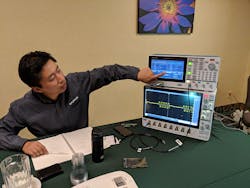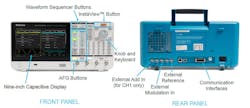The AFG31000—Modernizing the Arbitrary Function Generator
The test industry is sprinting to keep up with the accelerating rate of change in design complexity, lower costs, time to market, and the way in which we interact with devices and instrumentation. Yet, when it comes to the arbitrary function generator (AFG), there hasn’t really been all that much change. So, when Tektronix reps said they were coming by to show a ground-breaking AFG, it behooved me to take a look.
I was greeted by Eric Yang, senior technical marketing manager for Tektronix, who had traveled all the way from China just for the launch tour. That seemed special, until he said he’s back and forth regularly. Okay, so maybe it’s still special, and it was.
Yang sat next to a two-tier stack of equipment, but the AFG31000 was the instrument on top, and it sure looked better than the dowdy AFGs we’re used to seeing on benchtops in every R&D lab, school, and testbench for decades (Fig. 1).
1. Tektronix’s Eric Yang points to one of four of the AFG31000’s major innovations: a 9-in. capacitive multi-touch display that doesn’t void knobs and buttons but complements them—however, it might obviate user manuals.
In fact, it was almost unrecognizable atop the oscilloscope, so I had to ask to verify we were gathered to actually talk AFGs. We were, and the most startling aspect is the 9-in. capacitive multi-touch display that might just obviate the need for user manuals. The display has a resolution of 800 × 480 and doesn’t strive to get rid of buttons and knobs. Instead, it complements them with context awareness; depending on the option selected on screen, the appropriate buttons light up.
This approach to interfaces isn’t new for test equipment, of course. As engineers come out of school, they’re use to touch interfaces with swipe and pinch-and-zoom, so instrument manufacturers have been incorporating these features, especially into oscilloscopes. However, it’s new for AFGs. But wait, there’s more—three more, to be precise.
According to Yang, feedback from customers about current AFGs not only indicated frustration with the buttons and menus, but also with the limited ability to edit and program waveforms; poor support for waveform sequencing; and lack of memory and programming capability for in-depth testing.
Simply put, “The AFG is lagging behind,” said Yang. “They’re hard to learn and hard to use.” The AFG31000 is Tektronix’s answer to those problems, with advanced features that address each of those issues (Fig. 2).
2. A look at the front and back highlights the new features, but also the compact size, which was oddly not even part of the marketing promotion. It’ll fit on any benchtop, and jazz it up when compared to typical AFGs.
InstaView
Along with compact size and an intuitive interface, Yang was quick to talk about the new patented InstaView feature, not to be confused with Tektronix’s old InstaVu Acquisition Oscilloscopes (TDS500C/700C series) that are no longer being sold by the company.
That said, the new InstaView feature acts like an oscilloscope in that it detects impedance mismatches between the AFG and the device under test (DUT). If this impedance mismatch is simply resistance-based, the symptom is a 1-mV signal being potentially doubled to 2 mV. If it’s inductive or capacitive, it distorts the waveform. InstaView detects the reflected signal caused by an impedance mismatch and uses this information along with proprietary technology to rebuild the waveform being presented to the DUT. The designer in turn examines and modifies the impedance at the DUT accordingly.
The feature is so interesting I asked Yang to do a video demo. We did a preamble that goes over the other features too, so jump to timestamp 2:54 in the video to see how InstaView works:
InstaView isn’t intended to replace oscilloscopes, of course, but it does save time. And, according to Yang, one customer (TZ Medical) has already said the collective features of the AFG31000 have cut its typical setup and test cycle almost in half.
Internal Waveform Sequencer and Creation
The two other features new to this generation of AFG, which are also genuine time and space savers, are the integrated waveform sequencer and integrated waveform creation. Normally, an arbitrary waveform generator (AWG) is needed to generate and present complex, detailed waveforms to the DUT for validation and characterization. Not so with the AFG31000. Instead, an internal sequencer does this, at a fraction of the cost of an AWG. Yang goes so far as to estimate it to be about one-tenth the cost.
The sequencer provides 256 steps, up to 128 Mpoints/channel, and includes a variable sampling clock up to 2 Gsamples/s along with complex timing functions such as continuous, triggered, gated, and sequenced. It also retains waveform details, without skipping samples.
Like sequencer, the integrated waveform replaces another system; in this case, it’s the always-present PC. The PC is typically used to create, edit, and transfer arbitrary waveforms to the AFG, which then presents them to the DUT. Also, when waveforms are gathered using an oscilloscope, they can’t be loaded to the typical AFG directly. Even when they do get to the AFG, the signal amplitude information is normalized.
Using the ArbBuilder function in the AFG31000, all creation and editing functions are done on the AFG, thanks in large part to the advanced display. Oscilloscope files in .csv format can be directly loaded into the AFG from a USB stick, and those waveforms are of course no longer amplitude-normalized.
Other features of the AFG31000 include 10X less noise, 40X lower jitter, and 1000X more memory (compared to the AFG3000C class system), along with a long list of high-performance characteristics (Fig. 3). For a comparison, look to Keysight’s 33500B/33600A series.
3. The AFG31000’s features are many, but note the jitter, waveform length, sample rate, and sine and pulse ranges.
Pricing for the AFG31000 ranges from $2,210 to $14,100, depending on bandwidth (25 to 250 MHz), sample range (250 Msamples/s to 2 Gsamples/s), whether you need one or two channels, and which output voltage you choose (10 or 5 V p-p).
To keep abreast of pricing and available options, it’s a good idea to keep checking Tektronix’s AFG31000 landing page.
About the Author
Patrick Mannion
Founder and Managing Director
Patrick Mannion is Founder and Managing Director of ClariTek, LLC, a high-tech editorial services company. After graduating with a National Diploma in Electronic Engineering from the Dundalk Institute of Technology, he worked for three years in the industry before starting a career in b2b media and events. He has been covering the engineering, technology, design, and the electronics industry for 25 years. His various roles included Components and Communications Editor at Electronic Design and more recently Brand Director for UBM's Electronics media, including EDN, EETimes, Embedded.com, and TechOnline.




